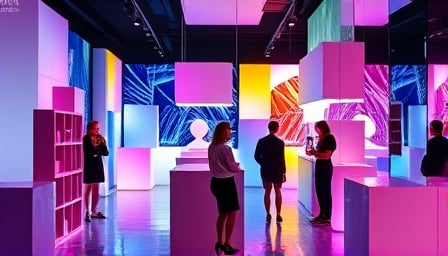Moncler SpA: Navigating a Shifted Consumer Landscape in a Digitally‑Hybrid Retail Ecosystem
Moncler SpA’s recent uptick in share value illustrates a broader narrative about how luxury brands are capitalising on evolving consumer habits, demographic currents, and cultural momentum. By weaving together digital innovation with experiential retail, Moncler is positioned to tap into the spending power of younger cohorts while sustaining the loyalty of its established clientele.
Digital‑Physical Synergy: A New Paradigm for Luxury
Luxury consumption has long hinged on the tactile allure of a flagship store. Yet the last decade has witnessed a pivot toward “phygital” experiences, where online platforms serve as extensions of brick‑and‑mortar touchpoints. Moncler’s recent marketing push emphasises high‑resolution virtual showrooms, augmented‑reality try‑on tools, and personalised e‑commerce concierge services.
The company’s digital investments have a dual purpose:
- Data‑Driven Personalisation – By aggregating purchase histories and browsing behaviour, Moncler can curate product recommendations that echo each customer’s lifestyle narrative.
- Omni‑Channel Consistency – Seamless cross‑sell between online and offline environments mitigates friction for the “shoppers who want to see, touch, and then purchase digitally.”
Such integration satisfies Gen Z and Millennials, who demand immediacy and interactivity, while reinforcing the premium brand aura that appeals to older, affluent buyers.
Demographic Shifts and Generational Spending Patterns
Gen Z: The Experience‑First Consumer
With a projected 12.8 million Gen Z consumers entering the 18‑24 age bracket by 2025, spending trends reveal a preference for brands that offer immersive stories over sheer product features. Moncler’s collaborations with street‑wear artists and limited‑edition capsule drops resonate strongly with this cohort, fostering a sense of exclusivity and belonging that traditional luxury brands have struggled to emulate.
Millennials: The Value‑Aware Affluent
Millennials, now in their late 30s to early 50s, combine disposable income with an appetite for sustainable, ethically produced goods. Moncler’s recent sustainability initiatives—such as the use of recycled down and carbon‑neutral logistics—address these priorities. By integrating transparent supply‑chain data into its digital platforms, the brand can reassure this segment that luxury and responsibility coexist.
Baby Boomers: The Stability‑Seekers
Despite a shrinking share of overall luxury spend, Baby Boomers remain a reliable source of high‑margin purchases, particularly for classic outerwear and heritage pieces. Moncler’s physical flagship stores, equipped with in‑store advisors and heritage‑themed lounges, continue to reinforce the tactile authenticity that this group values.
Cultural Movements: From Fast‑Fashion to Slow‑Luxury
The cultural shift towards “slow‑luxury”—where longevity and craftsmanship outweigh rapid trend cycles—has been accelerated by the pandemic and heightened environmental consciousness. Moncler’s product design philosophy, emphasising timeless silhouettes and exceptional material quality, aligns neatly with this movement.
Moreover, the brand’s recent foray into collaborative “street‑luxury” lines capitalises on the growing cultural fascination with hybridity: blending high fashion with urban aesthetics. These initiatives not only broaden Moncler’s appeal across diverse demographics but also create a narrative that can be leveraged across digital storytelling platforms.
Stakeholder Confidence and Market Momentum
Bernard Arnault’s decision to increase LVMH’s stake in Moncler to 22 percent is a tangible affirmation of the company’s strategic trajectory. Such backing brings:
- Capital Injection – Enables accelerated product development cycles and geographic expansion.
- Strategic Alignment – Access to LVMH’s global supply‑chain efficiencies and cross‑brand marketing synergies.
The market’s positive reception, reflected in Moncler’s outperformance relative to the broader Italian index, underscores investors’ confidence that the company will continue to navigate competitive pressures successfully.
Forward‑Looking Analysis: Opportunities and Risks
| Opportunity | Implication | Action |
|---|---|---|
| Digital Expansion | Growing Gen Z e‑commerce penetration | Invest in AI‑powered recommendation engines and immersive AR try‑on experiences. |
| Sustainability Storytelling | Rising Millennial ESG expectations | Amplify transparent supply‑chain metrics via blockchain‑verified labels. |
| Phygital Flagship Stores | Desire for tactile luxury coupled with digital convenience | Redesign flagship spaces into experiential hubs with digital concierge and real‑time inventory access. |
| Collaborative Collections | Cultural appetite for hybrid aesthetics | Partner with emerging street‑wear designers to create limited‑edition drops that create social media buzz. |
Risks to monitor include:
- Supply‑Chain Volatility – Raw‑material cost spikes could erode margins.
- Digital Saturation – Over‑commercialisation of digital touchpoints may dilute brand exclusivity.
- Competitive Aggression – New entrants offering “budget‑luxury” may erode the higher‑priced market share.
Conclusion
Moncler SpA’s recent market performance is more than a temporary rally; it reflects a strategic confluence of digital‑physical innovation, demographic alignment, and cultural resonance. By leveraging these trends, the company is poised to sustain growth, deepen customer loyalty, and capitalize on the evolving expectations of contemporary luxury consumers. The next several months will test how effectively Moncler can translate its brand promise into scalable, experience‑rich offerings that resonate across generations while maintaining the exclusivity that defines the luxury sector.
